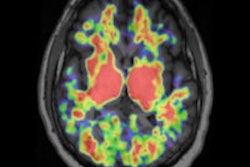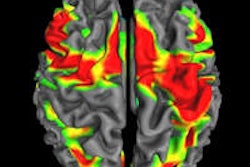For the first time, Swedish researchers have observed the progression of Alzheimer's disease with the use of PET and carbon-11-labeled Pittsburgh Compound B (C-11 PiB), according to a study published online December 13 in the neurology journal Brain.
Using C-11 PiB PET, the group found high concentrations of amyloid plaques during early stages of the disease, which coincided with the beginning of the patient's memory loss. The amyloid plaque levels also remained unchanged during the course of the disease as metabolism declined in the brain.
The lead author of the study is Ahmadul Kadir, MD, from the department of neurobiology at Karolinska Institute and Karolinska University Hospital Huddinge in Stockholm.
One trait of Alzheimer's disease is the accumulation of beta-amyloid proteins to form amyloid plaques in the brain. However, it is still unclear how early plaques form in the brain, whether they are the primary cause of Alzheimer's, or how -- or even if -- plaques influence other changes in the brain.
The subject of the Swedish study was a female patient who, at the age of 53 in 1999, was referred from a local hospital to the department of geriatric medicine at Karolinska. There was no family history of dementia or other neurodegenerative diseases in her medical record, but she began to experience cognitive problems in the form of memory loss a few years prior to her referral.
The patient underwent a series of clinical evaluations, which included cognitive screening, physical and neurological exams, and laboratory blood work. She also received CT, PET, SPECT, MRI, and electroencephalography (EEG) scans. While the CT scan was normal, her SPECT image showed decreased cerebral perfusion in the parietal cortex. The EEG also displayed a degree of decreased brain function.
She was diagnosed with Alzheimer's disease, received pharmacological treatment, and was clinically evaluated every six months from 1999 to 2007. The patient eventually died in 2007 at the age of 61.
Between 1999 and 2004, the patient underwent three PET scans (ECAT Exact HR+, Siemens Healthcare, Erlangen, Germany) with FDG at the ages of 53, 56, and 58. In February 2002, she received her first PET scan with C-11 PiB, and she underwent a second scan in August 2004.
The researchers designated a set of regions of interest in the brain to determine the relationship between the PET data and the patient's cognitive tests, and to compare the C-11 PiB scans.
The first neurophysiological assessment of the female patient at age 53 revealed significant cognitive impairment, particularly in regard to short-term memory, while verbal ability was intact. Over the next seven years, the patient's mini-mental state examination scores, which are designed to test cognitive skills, declined from 27 (out of 30) at age 53 to 5 at age 60.
The patient also showed a pronounced decline in cerebral glucose metabolism and cognition during the disease progression, while C-11 PiB retention remained high and stable during follow-up.
The researchers also obtained the patient's brain for autopsy 17 hours after death, focusing on nine regions of interest that included the frontal, temporal, parietal, and occipital cortices, as well as the anterior and posterior parts of the hippocampus. The autopsy confirmed the diagnosis of Alzheimer's disease, and the nine brain regions were analyzed to measure the regional distribution of beta-amyloid protein.
The C-11 PiB PET results positively correlated with PiB binding, total insoluble beta-amyloid, and beta-amyloid plaque distribution.
One new discovery by Kadir and colleagues was that the greater accumulation of plaque is accompanied by a reduction in the number of neuronal nicotinic receptors in the brain, which are essential for memory function. This new finding, the authors noted, demonstrates that the receptors are affected early in the development of Alzheimer's.
In addition, the researchers found inflammatory changes in regions of the brain with low levels of plaque, which suggests that the neuroinflammation related to Alzheimer's disease might have a different cause and evolve at different stage of the disease compared to the evolution of amyloid accumulation.
By Wayne Forrest
AuntMinnie.com staff writer
December 16, 2010
Related Reading
PET detects Alzheimer's disease likely to progress, December 15, 2009
MRI, PiB-PET may help distinguish dementias, May 4, 2009
PET, PiB support cognitive reserve hypothesis in Alzheimer's, November 14, 2008
PET with C-11 PiB can assess beta-amyloid brain deposits, August 12, 2008
Copyright © 2010 AuntMinnie.com



















